Kona is Hawaii’s best place for diving because it has such a wide variety of underwater terrain and marine life. From tiny little critters to animals that are many times the size of a human, we’ve got it all. This includes 9 different species of shark that are seen commonly and a few that are around but rarely seen. This doesn’t even include the rays which are a closely related cousin to the sharks.
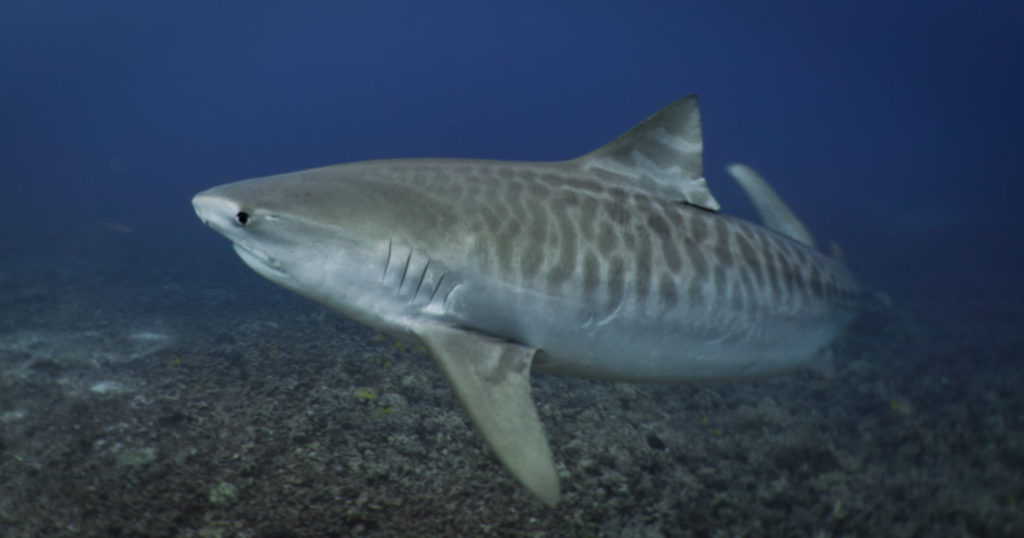
In this Guide
The Best Ways to See Sharks in Kona
The Best Ways to See Sharks in Kona, Hawaii
Kona shark diving is not well known but that doesn’t mean there isn’t anything to see. In fact Kona is home to some of the best shark diving in the world. People will come to Kona after visiting ‘Tiger Beach’ in the Bahamas and spending thousands of dollars only to see Tiger sharks for the first time here on their first dive!
Options for Shark Diving in Kona
- Dive with Kona Honu Divers
- Pelagic Snorkeling
- Shore Diving
- Cage Diving (not in Kona)
#1. Scuba Dive with Kona Honu Divers
Scuba Diving is the best way to see sharks in the their natural habitat. For some reason when wearing a scuba tank sharks seem to behave around divers. This means divers can get up close and personal with these special creatures.
While there doesn’t exist a Kona shark diving experience that is exclusive to seeing sharks, Kona Honu Divers offers 3 dive tours where you can see sharks. While they are not always seen on these dive trips there is a possibility.
2-Tank Morning Dive
On the 2-Tank Morning dive tour we regularly see sharks. Tigers are more common in the summer but can be seen year-round on Kona’s reefs. Whitetip reef sharks are the most common sighting at sites like Suck-em-up where they will sleep in the cavern that gives the dive site its name. It’s also possible to see hammerhead sharks which are more common in the winter months and tend to hang out near points at sites like Pyramid Pinnacles and the surrounding sites.
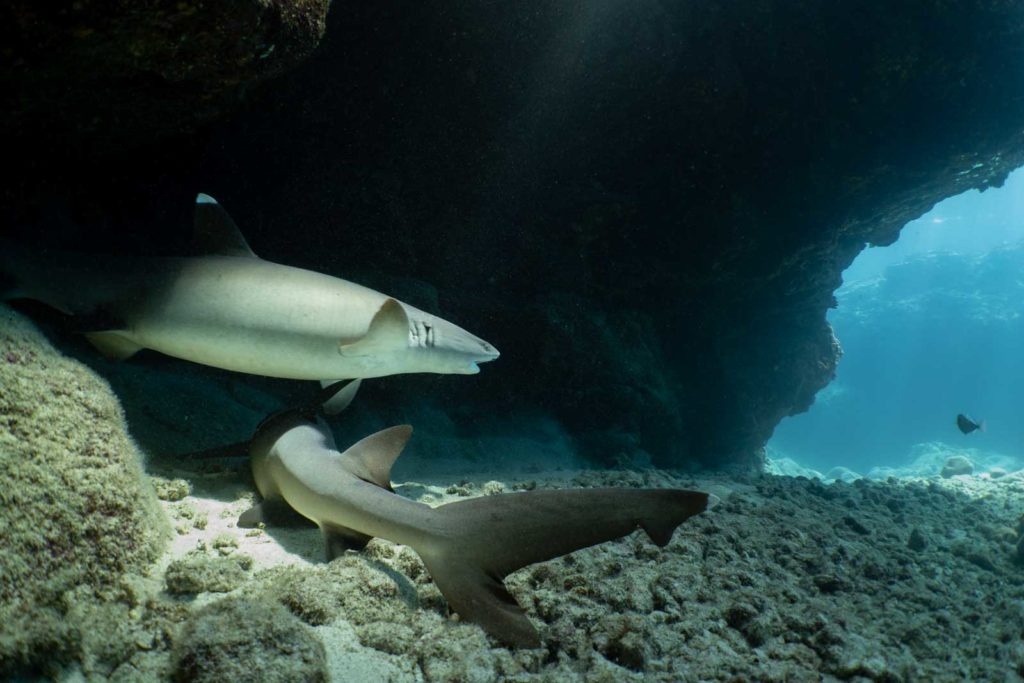
Premium Advanced Long-Range Dive
This dive is more exclusive and visits more far-flung dive sites. One of the best sites for Kona shark diving is Touch of Grey dive site. This site gets its name from the shiver of baby grey reef sharks that use its 80 foot deep arch for shelter. We’ve seen as many as twenty of the little guys under there at a time. They can be skittish so it’s important to approach slowly so as not to spoil them from their hiding spot.
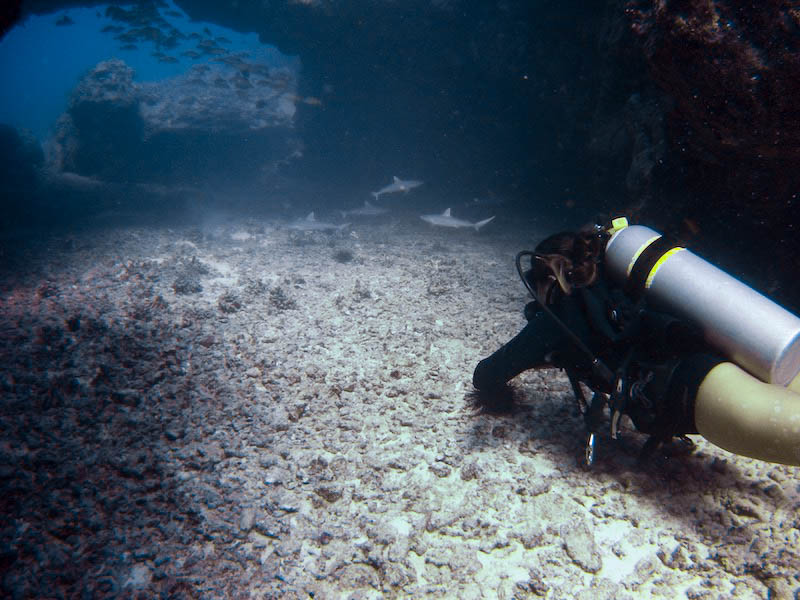
At other advanced sites it’s possible to see whitetip reef sharks or tiger sharks on occasion. If you’re lucky you may even spot a whale shark on the way to the dive site or during a dive!
Blackwater Night Dive
While it’s not common to see sharks on this dive, when you do it’s a memorable event! According to the world expert Blackwater dive guide and scientist Jeff Milisen they are seen about 5% of the time (1/20 chance). The most common sharks seen on this dive is the silky shark which spends most of its time offshore.
One of the most unique and elusive sharks in the world, the cookie cutter shark is another potential sighting. While they are not commonly seen on this dive there’s no other way to see these extremely rare critters and this is one of the only places in the world to see them alive. While extremely rare, we’ve seen other sharks on this dive such as threshers, blue sharks, and even a whale shark!
#2. Pelagic Snorkeling on an Open Ocean Safari
For something completely different (yet still amazing!) you can try something uniquely offered in Kona: Pelagic snorkeling safaris. Imagine shooting across the water in search of large pelagic marine life on a 40 foot navy jet boat. You’ll be standing to help absorb the bumps and covering vast expanses of open ocean in search of some of the wildest large marine life in the pacific.
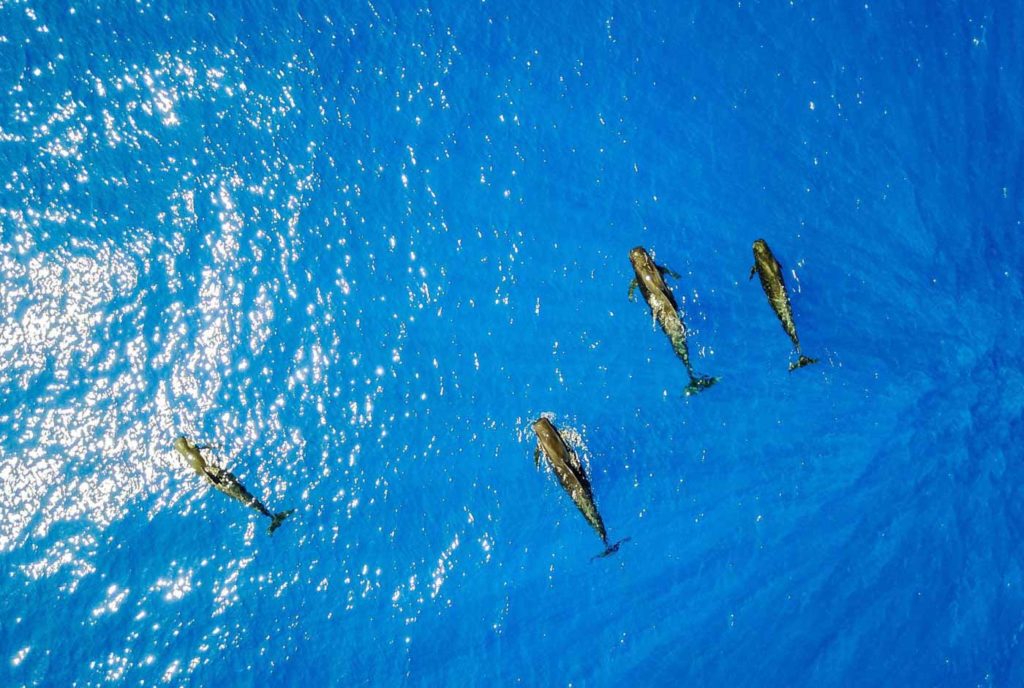
The best opportunity is to see oceanic whitetip sharks as they follow pods of pilot whales offshore. It’s believed that the pilot whales poop out the remains of the squid they ate the night before. This is what the whitetips are hoping to snack on before heading off into the blue.
In February it’s a good time to go cruising for schools of hammerhead sharks on this boat as it can cover the most ground. The schools can move miles in one day so it’s better if you’re on a more mobile boat to increase the odds of seeing this amazing phenomenon.
It’s also possible to see whitetip reef sharks and tiger sharks on the reefs on this epic excursion. Shark diving Kona has so much variety!
#3. Shore Diving
While going from shore is not the easiest way to see sharks, it is one way to see them. Here’s a few common spots to see them.
Kona Shore Divers
Offering the only shore diving experience on the west side of the Big Island, Kona Shore Divers can take you to the best sites for Kona shark diving. They know all of the best entry points, provide gear, and will give you the best chance to see sharks from shore. Select “TheOriginal Kona Tiger Shark Challenge” from their menu.
This is a great opportunity for families that want to hang out on shore at the beach or divers that get sea-sick easily.
Kua Bay
This is a common resting place for whitetip reef sharks. Swim north along the rock wall where the reef drops off into the sand and peek under the rock ledges. This is a great spot to look for whitetip reef sharks. It’s also a good place for the family to hang out if they won’t be diving. You can pick up rental gear before you go.

Learn more about this and other shore diving sites here.
Crescent Beach (Alula Beach)
This is the beach on the south end of the Honokohau Harbor located several hundred feet from our boat slip. It’s a rocky somewhat long path to the beach when wearing heavy dive gear and there’s lots of boat traffic coming in and leaving the harbor so it’s best to stay in the 40 feet and less depths to avoid boat traffic overhead.
You can get Kona’s best shore diving here before you go.
Shark Cage Diving In Oahu (Not in Kona)
While it’s not located on the Big Island of Hawaii in Kona, you can more reliably see sharks on the Island of Oahu with North Shore Shark Adventures by taking their boat offshore and hopping in a cage with snorkel gear to see sandbar and silky sharks up close and personal. This tour is a great option for non-divers.
While it’s not in Kona, and it’s likely you won’t see the coveted tiger shark, it is a reliable and easy way for just about anyone to see sharks up-close-and-personal in Hawaii.
Sharks Seen in Kona
About Kona’s Sharks
While seeing sharks in Kona is never guaranteed, it does happen from time to time. Some sharks are more commonly seen and others are extremely rare. We’ve listed the different sharks we’ve seen out in the wild in order of popularity based on the frequency we see them.
Tiger Shark
One of the biggest and most sought after Kona shark diving goals in Kona is seeing the Tiger shark. Scientists believe there are approximately 1000 individuals visiting the Hawaiian Islands. We often see the same ones and there’s even a project created by our Blackwater Expert Jeff Milisen to identify and name them.
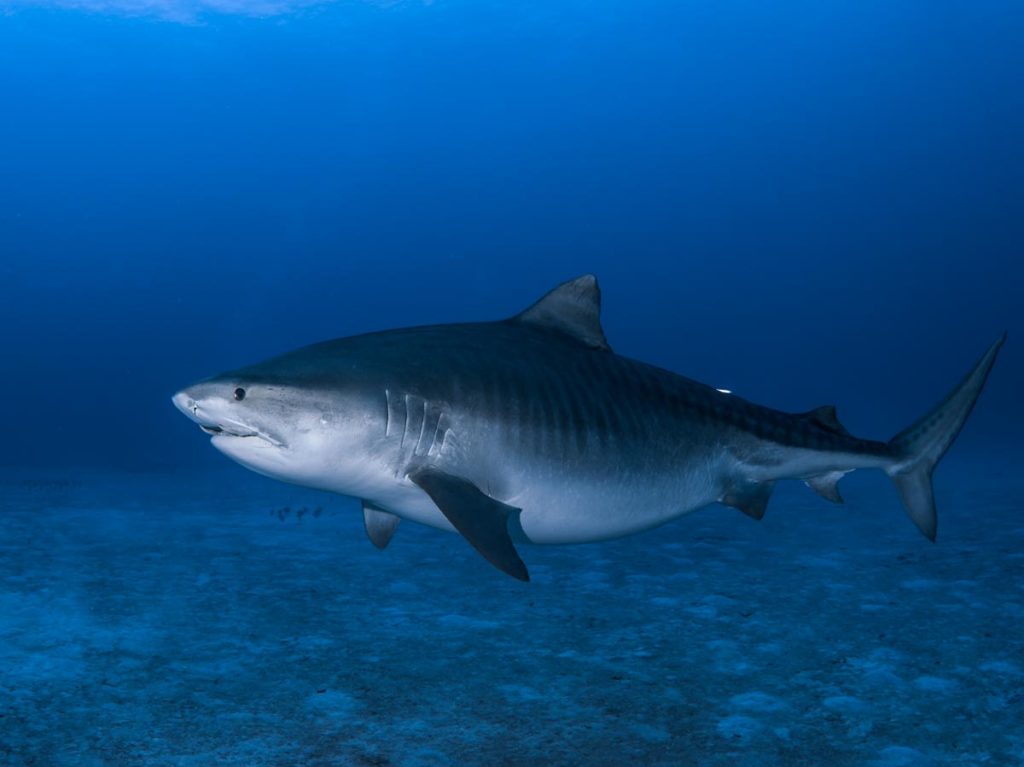
Many divers talk about Laverne, one of the sharks seen here. She is one of the larger tigers that frequent Kona and many people talk about seeing her even though they may have seen another shark. If you think you’ve spotted a new unidentified shark you can submit your photo of the left side of the animal to the project.
Tiger sharks are the ultimate opportunist feeder looking for anything that is edible and sometimes isn’t. While they have tried to feed on surfers, snorkelers, and spearfishermen it is not common. They typically go for prey such as sea turtles and birds. Tiger sharks really like slow moving prey like dead fish.
Whitetip Reef Shark
The whitetip reef shark is probably the most commonly seen shark in Hawaii. While Kona has other sharks that are more commonly seen, the whitetip is still a staple of shark sightings when diving the reef. Whitetip reef sharks usually take it easy during the day. Occasionally divers may spot them swimming along the reef but often they are sedentary choosing to rest in caverns and under rock ledges.
To see these sharks up-close and personal check out The Best Ways to See Sharks in Kona.
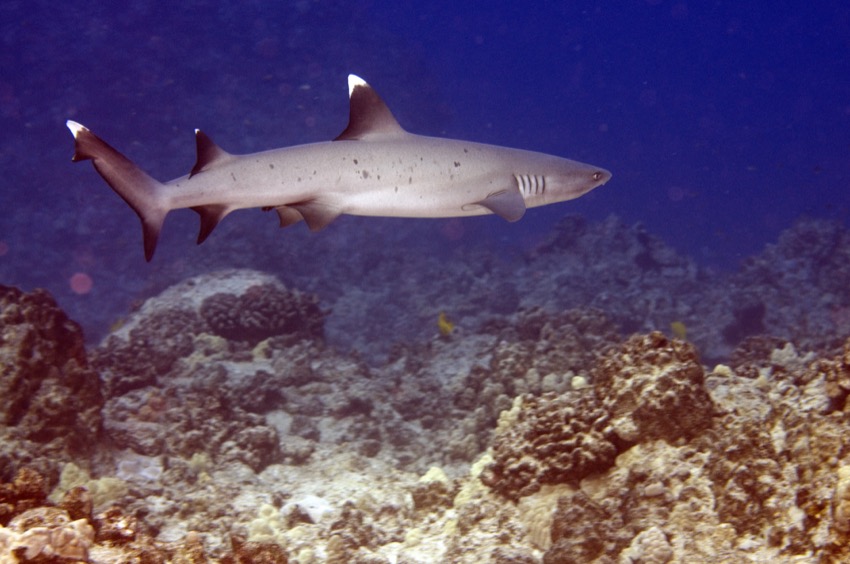
Oceanic Whitetip
Infamous in the open ocean, the oceanic whitetip has claimed more human lives than any other shark. If you’re stranded in the open ocean this is the shark that is most likely to find you first. Commonly found following pods of pilot whales or circling buoys where fishermen aggregate, the oceanic whitetip is about as far from the whitetip reef shark as a shark can get. While a white-tip reef shark spends most of the day sleeping in caves the oceanic whitetip spends most of its life swimming in the open ocean.
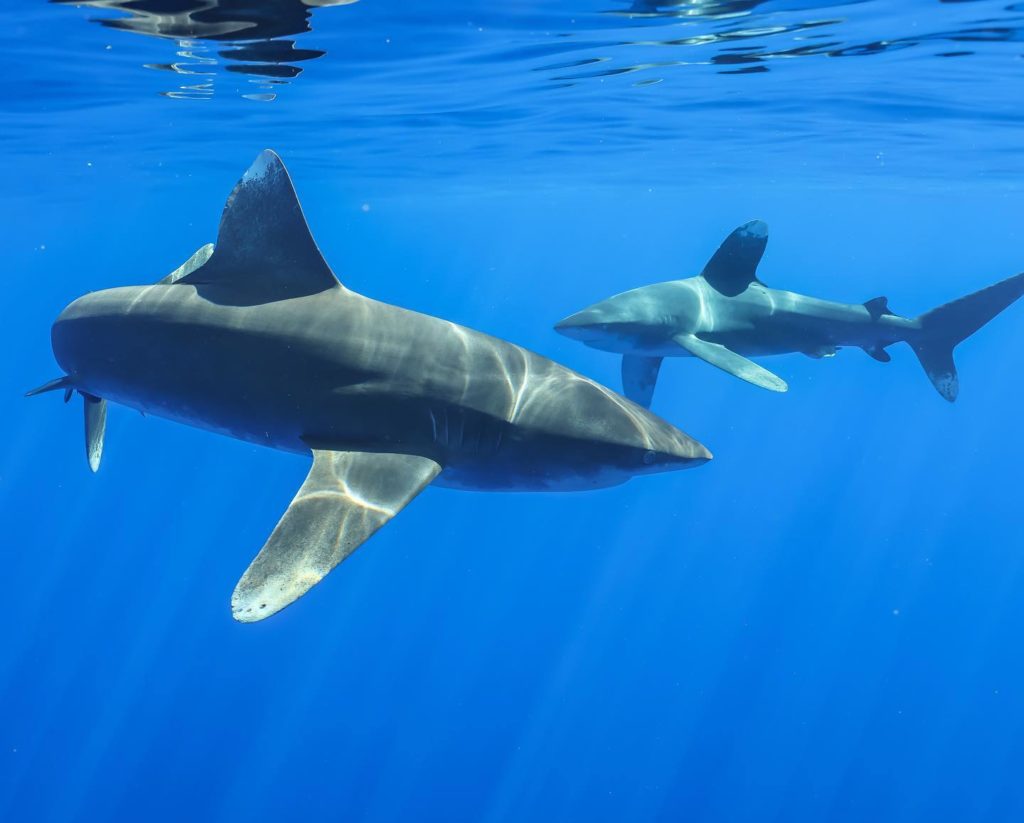
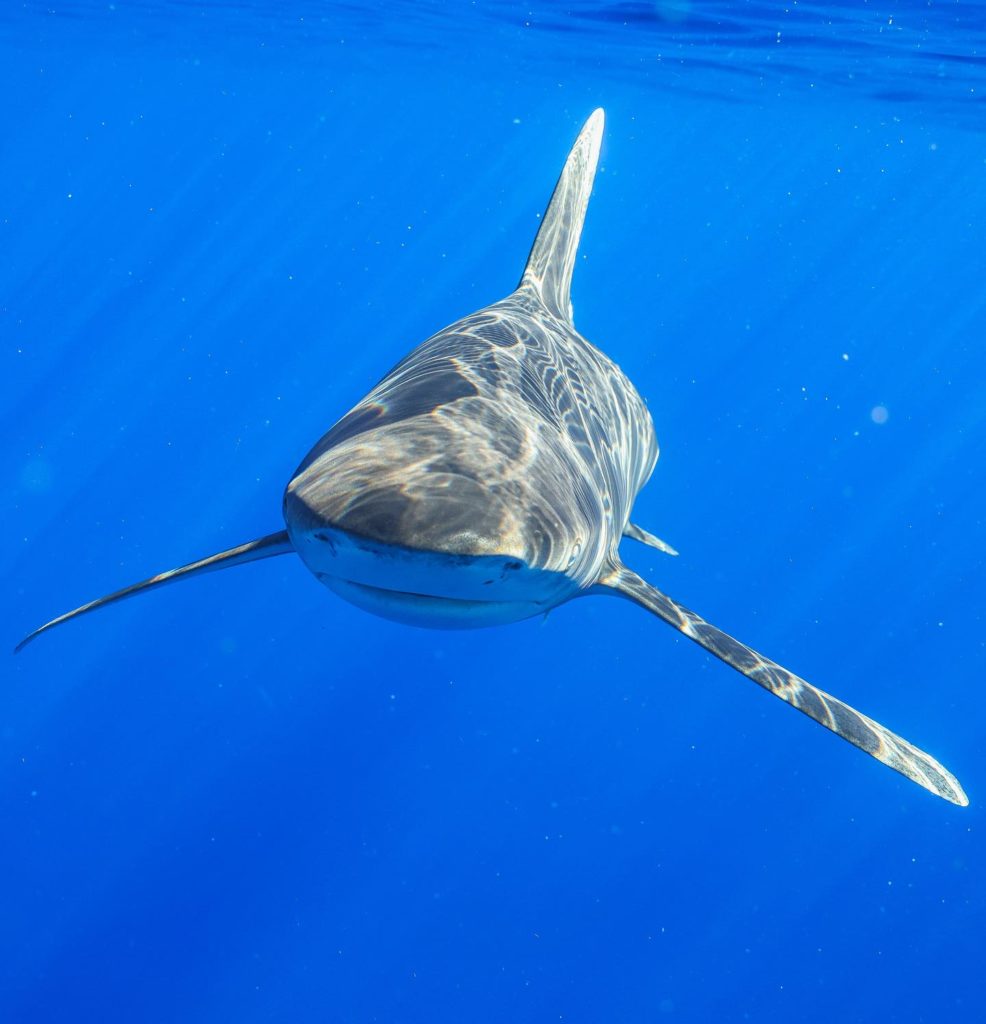
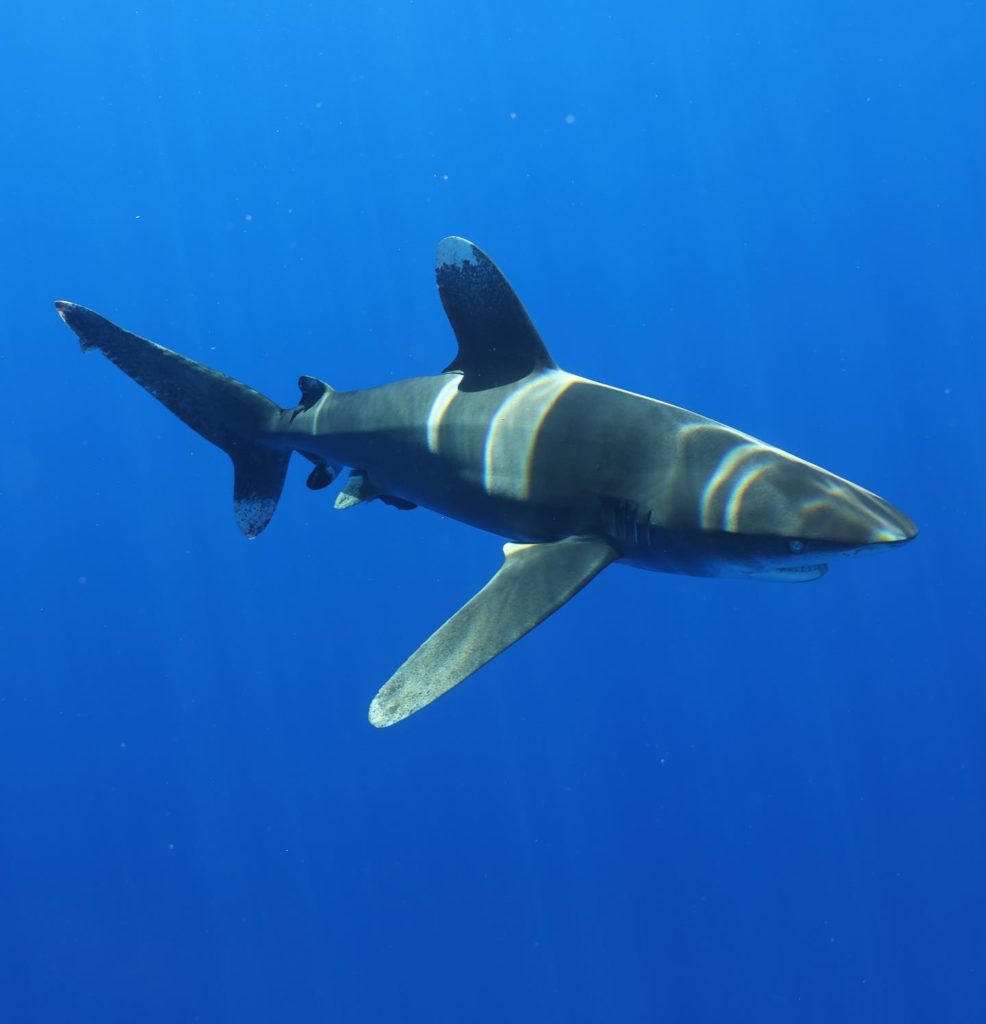

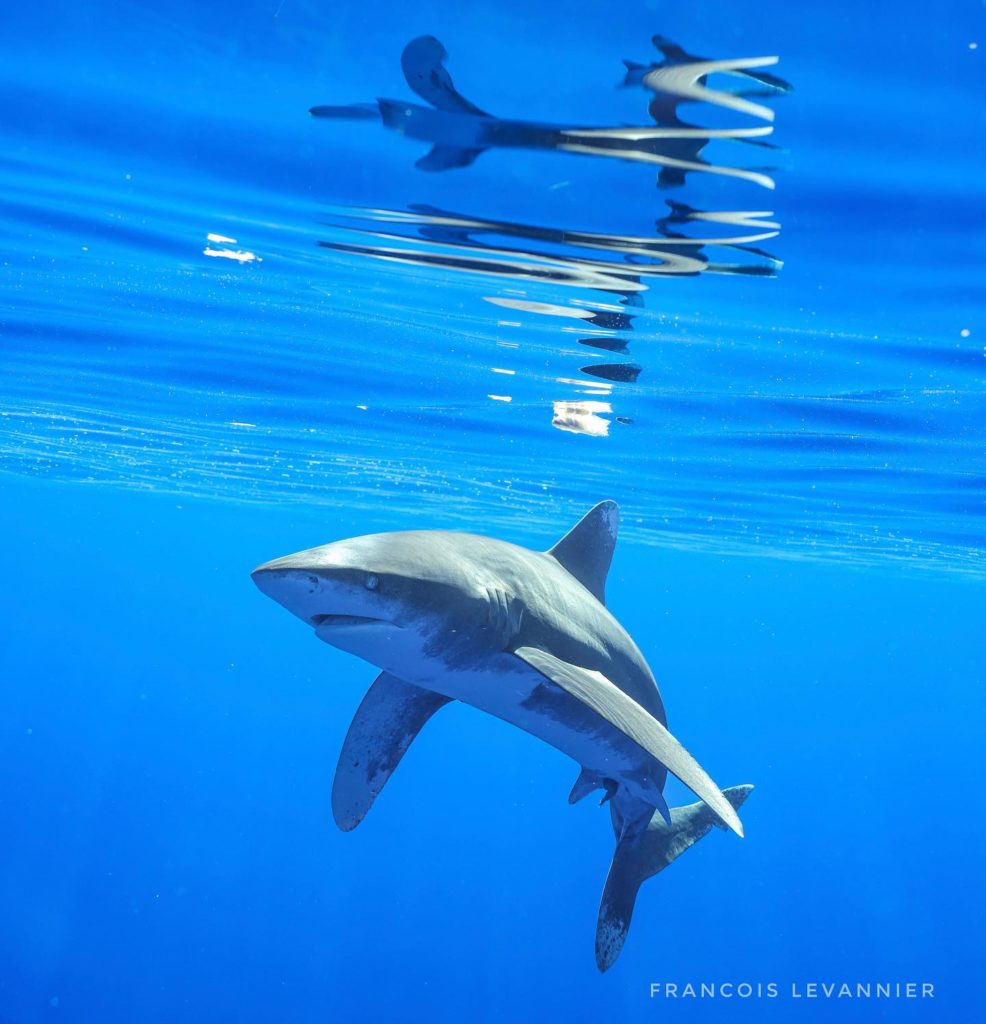
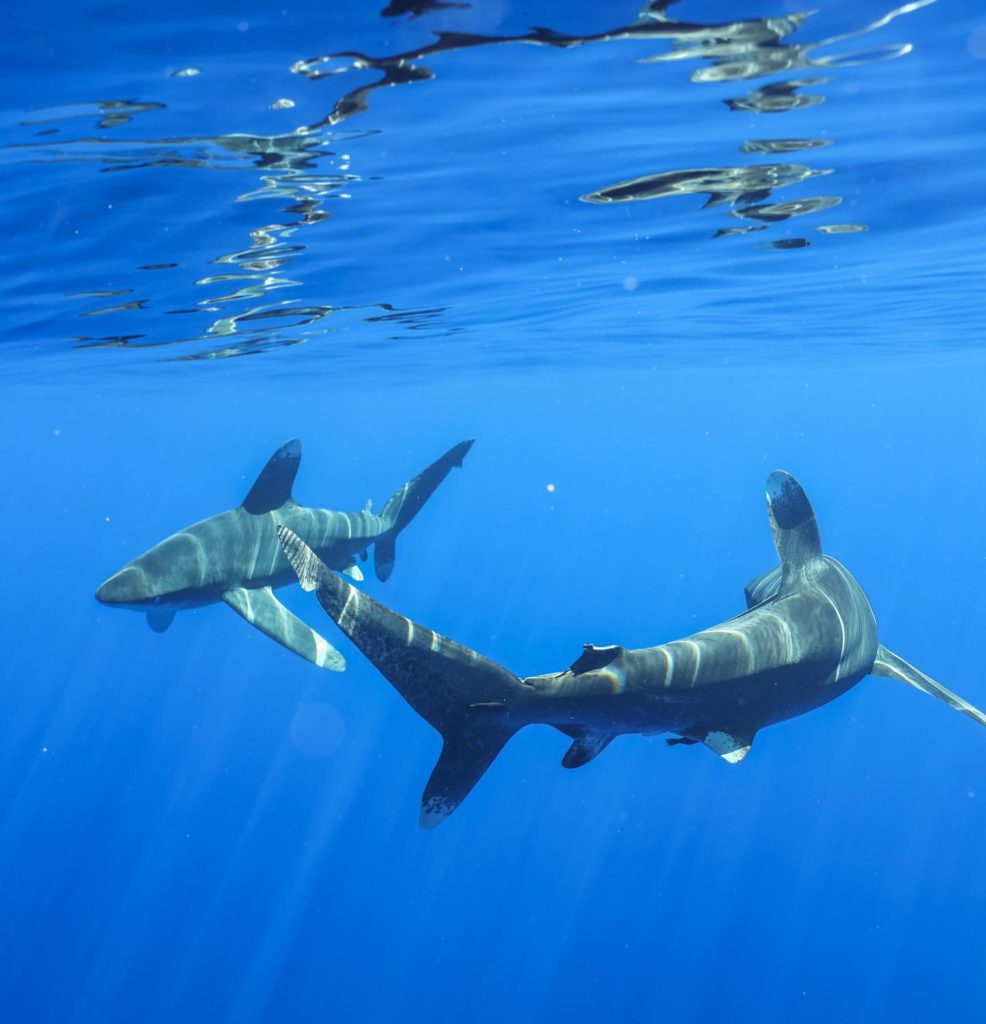
Rarely seen near shore, the oceanic whitetip is extremely curious. Few sharks will swim straight at you . . . and then keep coming . . . and then turn at the last second. Their aggressive behavior is a tool to determine if you’re food or foe. In which case it’s best not to swim away. Confronting this animal and looking at it with both eyes is your best defense.
While most divers are afraid of large sharks like the tiger shark or great white, the truth is oceanic whitetips should be feared far more than any of those animals.
With large puppy-dog like fins the oceanic whitetip is distinctive from the white-tip reef shark in both its appearance and its demeanor. The two could not be more different.
Sandbar Shark
Usually keeping offshore, these frisky sharks are most often encountered during sunrise/sunset near the boat harbors or anywhere there might be some easy pickings of fish remains. They are easily identified by their pointy triangular shaped dorsal fin.
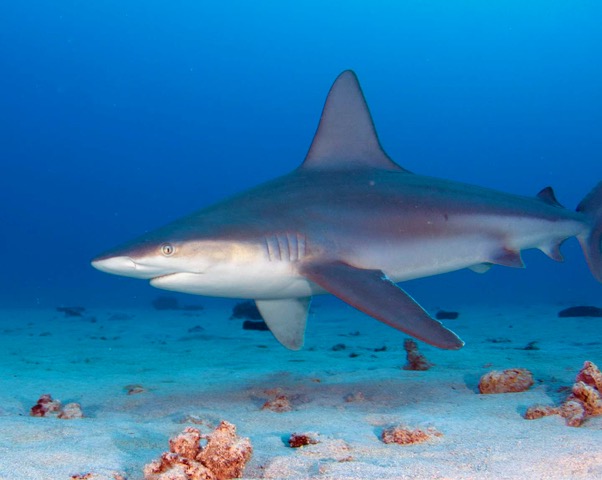
Photo By Jeff Milisen
Silky Shark
Silkies are most often seen offshore. They are a pelagic shark similar to the oceanic whitetip. While typically less aggressive than the whitetips they will get pretty interested if there’s fishing involved.
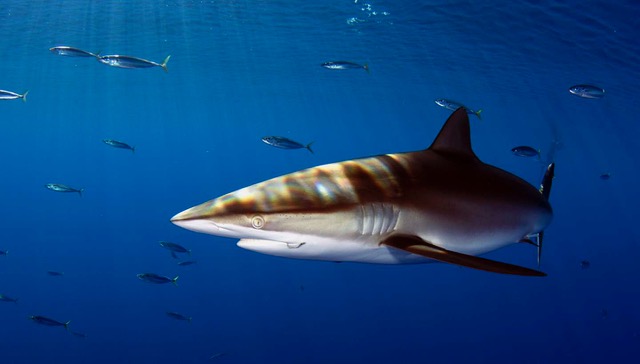
Photo By Jeff Milisen
While not common, these curious critters are the most often seen shark species seen on the Blackwater night dive.
Grey Reef Shark
The grey reef shark is not commonly seen in Kona. It’s possible to see them in the early morning in deeper water but in general they are not typically found out and about like some of the other sharks on the list.
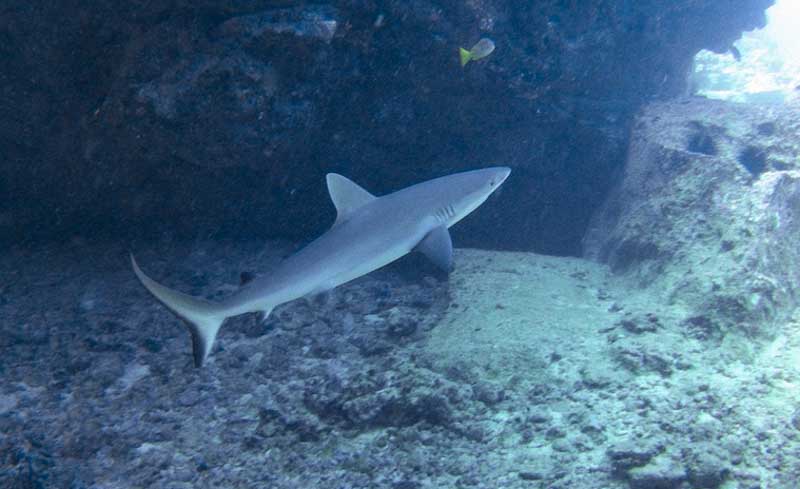
The best place to see grey reef sharks is on the Premium long-range advanced dive trip with Kona Honu Divers where we occasionally visit Touch of Grey Dive site to see, among other things, a shiver of baby grey reef sharks.
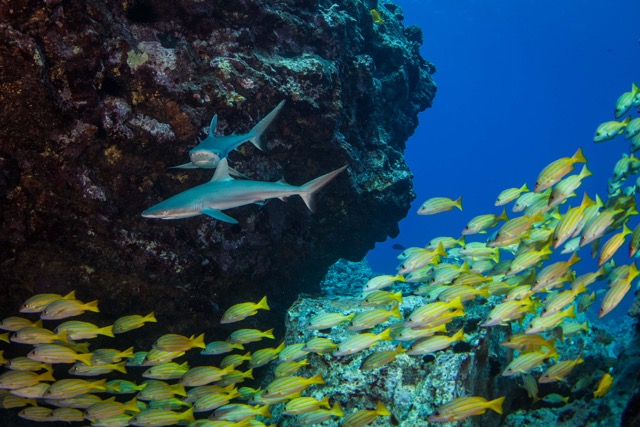
Whale Shark
Whale sharks used to only be seen in Kona during the winter months but over time they have become more common year around. While they are not easy to find, when we do see them it’s because they found us! Keep an eye out when diving because you never know when one might cruise by near the reef. We see them several times a year under the water on our dives.
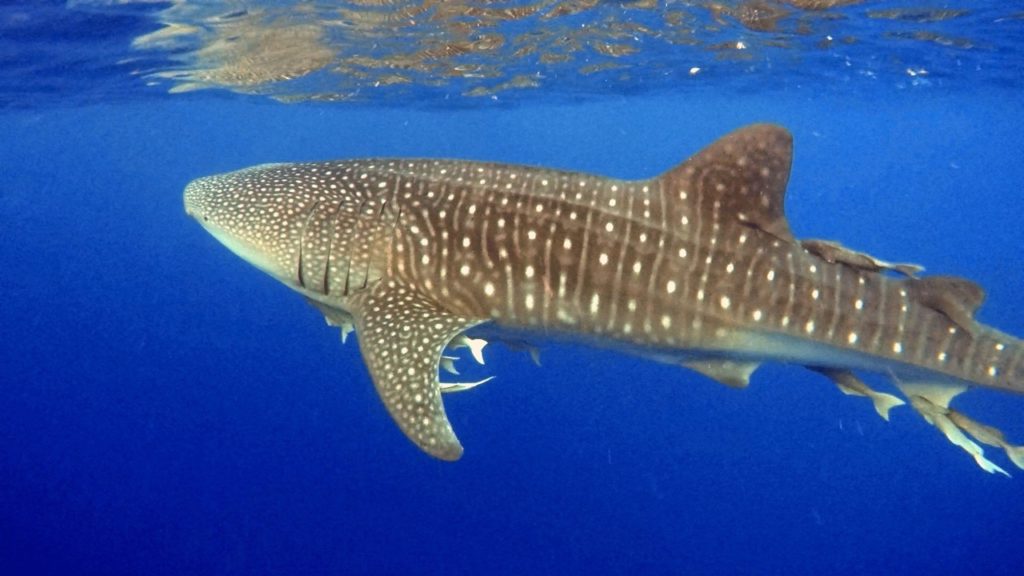
For the best opportunity to spot these curious gentle giants take an Open Ocean Safari Tour.
Hammerhead Shark
While Hammerheads are not commonly seen year around they are more often seen in the winter months from January to March. They will aggregate into massive schools of several hundred and swim slowly off shore. You may spot them by their fins which pierce the surface as the alpha female keeps the pace at the top of the group.
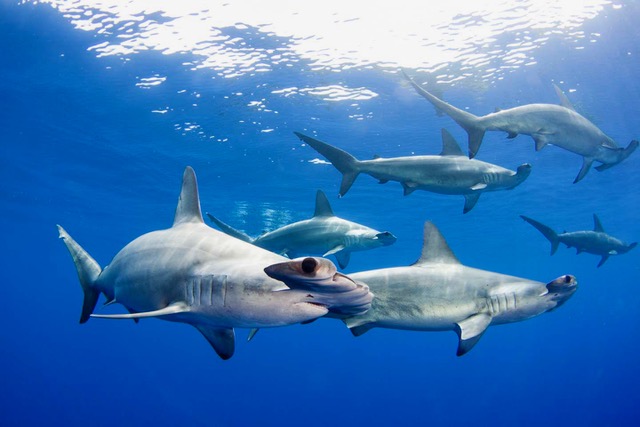
Individuals or pairs can be seen near points on our 2-Tank morning dive.
Oceanic Black Tip
Oceanic Blacktips are a semi-pelagic shark that walk a fine line between reef cruising and open ocean. These sharks prefer dropoffs and steep slopes and can sometimes be seen on our local dive sites, and even on our Manta 2-tank night charter, where they come in occasionally from the Kampachi fish farms offshore.
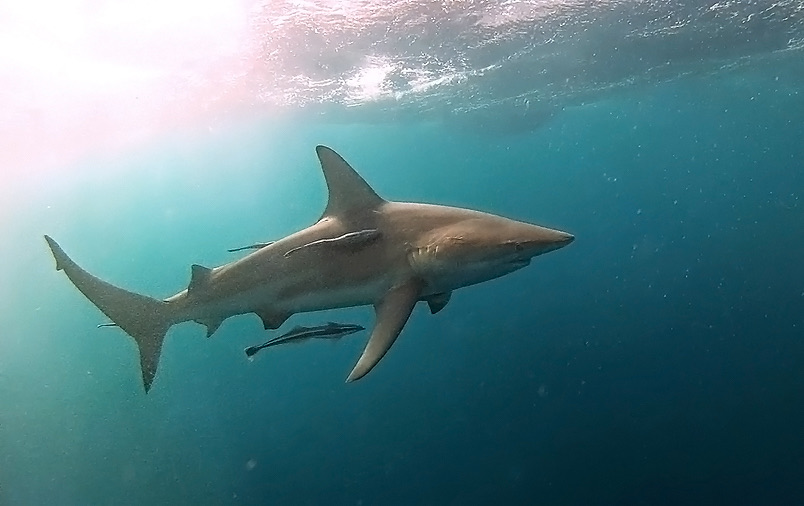
Cookie Cutter Shark
One of the Rarest sharks in the world because they are hard to spot. These small ambush predators resemble soggy cigars with giant glowing eyes and have been spotted many times on our world-famous Kona Blackwater Dive. Divers have about a 1-2% chance to see one on their Blackwater dives, and their sneak-attack behavior might be a good reason to abort the dive if one is sighted.
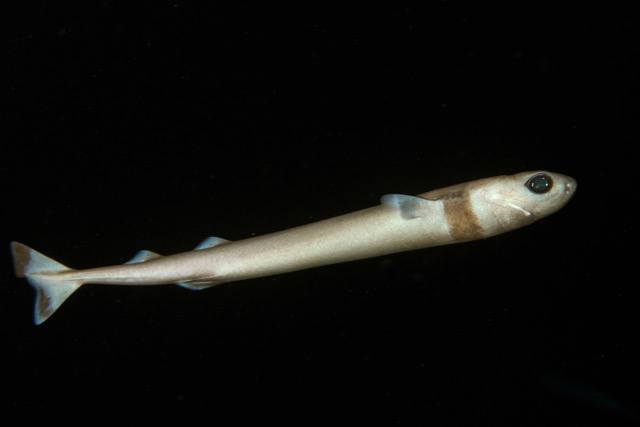
Cookie cutter sharks use hit and run tactics on their prey taking a quick bite and leaving with a mouthful. Scars are commonly seen on large pelagic critters such as dolphins and tuna.
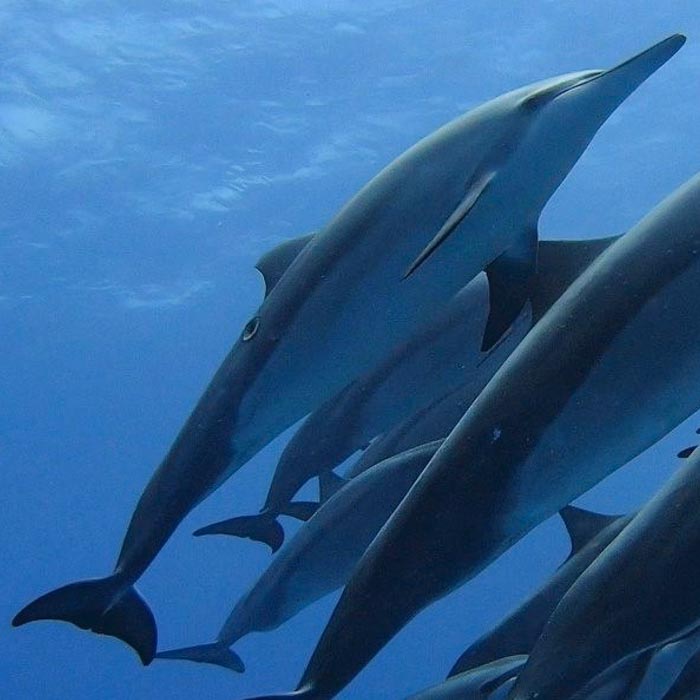
Great White Shark
While extremely rare in Kona they do come through every now-and-again. We hear stories about once a year of an encounter. Great White sharks are cosmopolitan species meaning they travel all around the world so it’s possible to spot them just about anywhere.
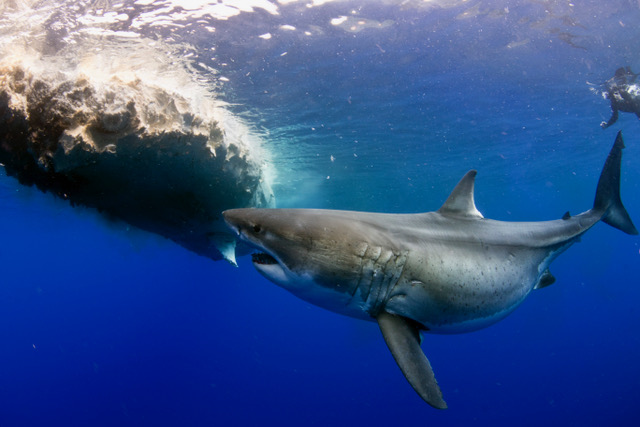


Photo By Jeff Milisen
They may swim up to snorkelers but we have yet to hear about aggressive behavior towards anyone.
Thresher Shark
An extremely rare sighting for Kona would be to spot a Thresher shark. The best opportunity to see these beautiful sharks might be on the Blackwater dives – but out of Jeff AND Sarah’s cumulative Balckwater experiences, only Sarah has been so fortunate to see one, just one time!
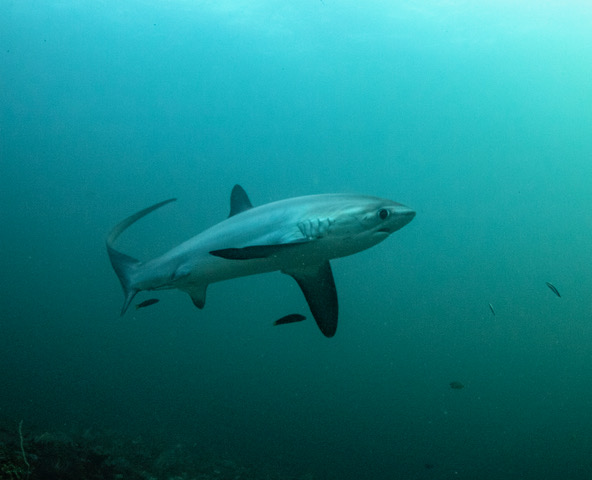
Photo By Jeff Milisen
Blue Shark
Blue sharks are actually more common than we suspect. Blue sharks are often caught in Hawaii on tuna long-lining vessels. Scientists speculate that Blue sharks are vertical migrators and come up from the deep pelagic ocean at night to warm up or hunt, and is one of the most common sharks that Sarah has had to “maneuver” away from divers on Blackwater Night Dive encounters.

Photo By Jeff Milisen
Kona’s Rays
Kona has 4 different ray species that can be seen here. While there are fewer types of rays they are easier to spot because they are often cruising the reef during the day while most sharks are sleeping in caves or hanging out offshore.
Manta Ray
The most sought after and one of the most often spotted rays is the reef are Manta Rays. Kona is world famous for its manta rays and one of the most popular activities on the Big Island is to Dive with Manta Rays at night. For those that can’t dive snorkeling with manta rays is amazing.
Eagle Ray
The Eagle ray is arguably the most commonly seen critter in this guide. It’s often seen when scuba diving or snorkeling on the reef. It’s more often seen at specific sites but can be seen just about anywhere. Sometimes it’s even possible to spot multiple eagle rays schooling together, though it’s not common.
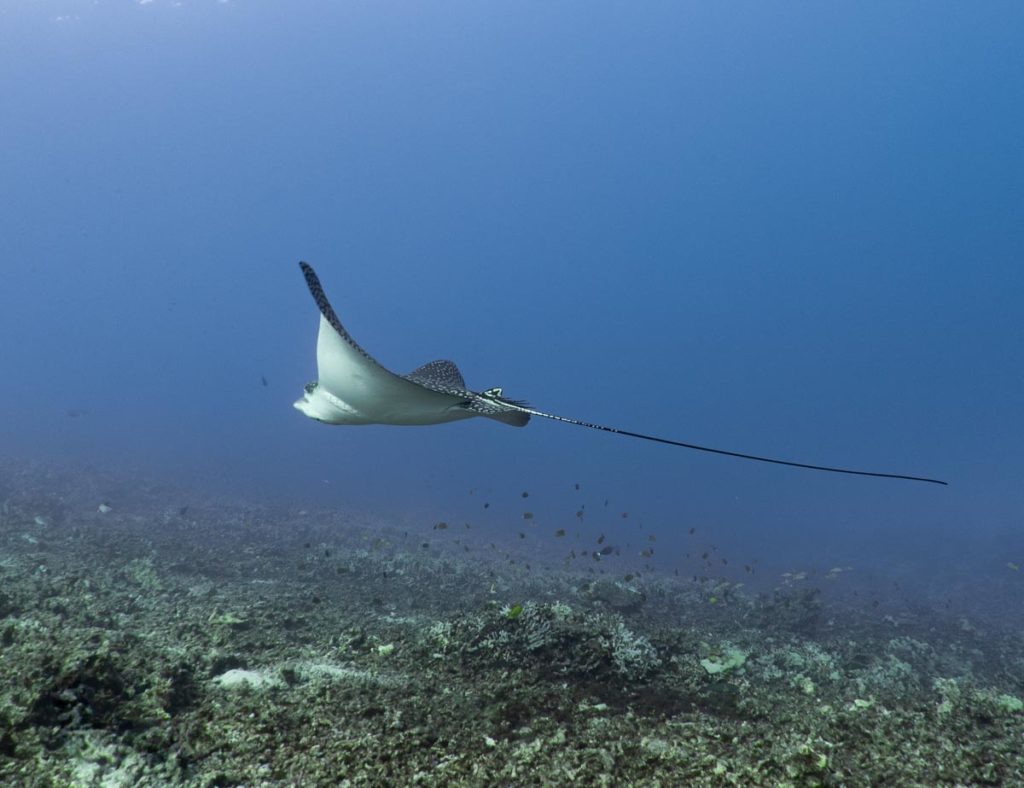
Eagle rays find their food in the sand so they can be seen near where the reef meets the sand or even crossing the reef to get to another feeding ground. Their finspan is usually around 3-5 feet (1-1.5 meters) but they can get much larger and if you’re lucky you can even spot cute little small ones that are much smaller.
Oceanic Manta Ray
Much less commonly seen than the reef manta ray, the pelagic manta ray is much larger and has a darker belly. They can get as large as 22 feet across. This is about twice the size of the largest reef manta ray.

Photo By Jeff Milisen
Hawaiian Stingray
One of the rarest critters seen on the reef is the Hawaiian stingray. With a large disk-shaped body these animals are quite large. While it’s possible to see them on the reef good luck finding one! In thousands of dives most divers will never see one of these rare rays.
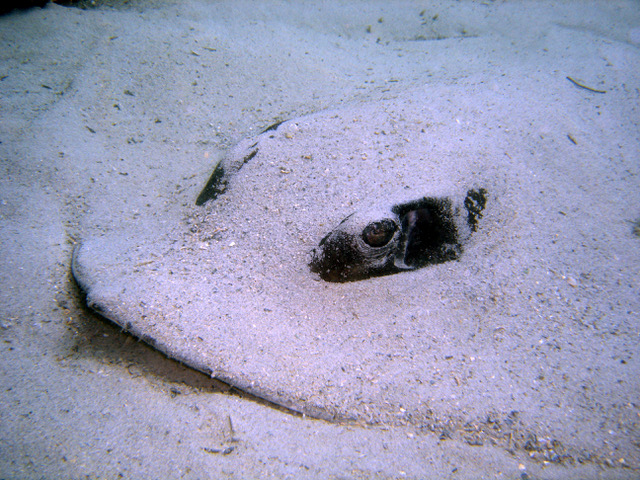
Photo By Jeff Milisen
Frequently Asked Questions
Can you shark dive on the Big Island of Hawaii?
Sort of. You can go diving with the intent of finding sharks but sometimes you won’t see them. They are wild animals after all.
What time of year are sharks most active in Hawaii?
Summer is the best time to see Tiger sharks which are one of the most sought after shark here. Hammerheads are best seen January through March and the rest are around year around.
Are there tiger sharks in Kona Hawaii?
There are around 800-900 Tiger sharks that visit Hawaii. A large number frequent the Kona coast divers will more often see them in the summer months.
What kind of sharks are in Kona Hawaii?
There are 13 different sharks seen in Kona’s waters but Tigers, White-Tip reef sharks, and Whale sharks are the most common.
Where can I see tiger sharks in Kona?
Typically the best place for scuba divers to see tiger sharks is diving off of Crescent Beach (Alula Beach). They are more commonly seen in the summer months. Some divers will dive the site multiple times without ever seeing one.
Which Hawaiian island has the most tiger sharks?
Tiger sharks are most commonly seen in Kona on the Big Island of Hawaii.
What is the most aggressive shark in Hawaii?
The oceanic whitetip is renowned for its aggressive approach. They will ‘test’ a swimmer/diver by heading straight for them. If the swimmer swims away they treat it like prey and chase after it. If the swimmer/diver faces the shark they are less likely to get more curious. The oceanic whitetip is the shark that most often causes divers to get out of the water when encountered because of their aggresiveness.
Are tiger sharks aggressive?
Not typically. Like many sharks they will most often become aggressive when they encounter prey they can ambush or is most obviously edible and easy to consume. They are opportunists and will go after anything they think they can eat (and some things they can’t).
When divers encounter these large sharks they are usually aloof, continuing on their way without care.
Are there great white sharks in Kona?
Occasionally. Great white sharks have been spotted rarely in Kona waters. Since they are a cosmopolitan species they can be spotted just about anywhere in the world.
What beach has the most tiger sharks?
Crescent Beach (Alula Beach) is possibly the most common place to see tiger sharks in the world. They probably like it there because of the steep dropoff and the Harbor which is the Billfishing capital of Hawaii.
Are tiger sharks safe to swim with?
In general yes.
Tiger sharks have been known to attack swimmers and snorkelers rarely but will typically leave scuba divers alone. As a rule if you’ve seen it, it’s probably okay. If you do spot one and it seems curious don’t swim away as it may prompt it to chase you. Always face the shark and look it in the eye.
What time of year are tiger sharks in Hawaii?
They are more often seen in Kona during the summer months, but still are seen year-round.
Are there whale sharks in Kona?
Whale sharks are seen regularly in Kona year-round. Research is currently being conducted to determine if there is seasonality to their movements.
Do tiger sharks come close to shore?
Yes. They will swim in shallow water but it is uncommon. While rare sometimes tigers are spotted at the beach in Hawaii and the life guards will ask the swimmers to get out of the water.
Are tiger sharks aggressive to scuba divers?
Not typically. It’s extremely rare that a tiger will go for an exploratory bite on a diver. For some reason they just don’t see scuba divers as prey. They are opportunists so they usually go for easy prey.
Are tiger sharks rare in Hawaii?
It depends. In places like Kona they are more commonly seen by scuba divers in certain locations where they come into shallow water. They are all over Hawaiian waters but they tend not to come into shallow waters so most swimmers and divers would never know they are nearby.
Are there a lot of sharks in Kona Hawaii?
It depends. Most people visiting will never see sharks here. But if you really want to see one there are a few ways to increase your odds of seeing a shark in Hawaii.
Is there shark cage diving in Hawaii?
Yes. There is a shark cage diving outfit in the north shore of Oahu called North Shore Shark Adventures that takes people offshore to snorkel in a cage with sharks. This is possibly the best way to encounter sharks in Hawaii for those looking for a good chance to see sharks ‘in the wild’ in Hawaii.

